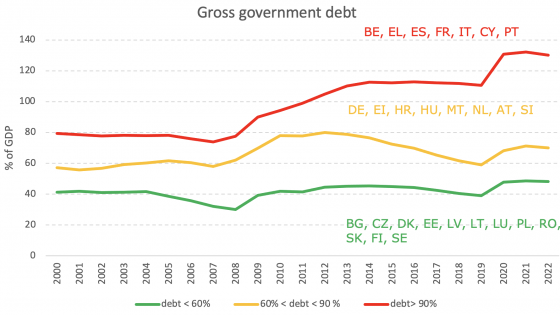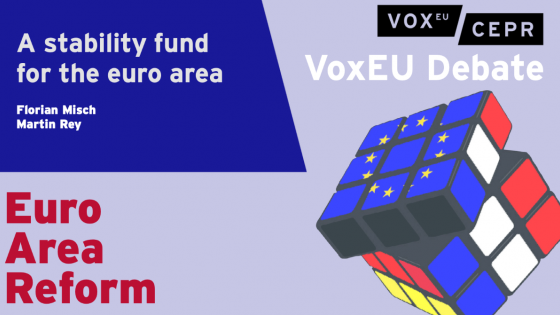One can no longer be sure whether Europe is just at a crossroads or on the brink. The multi-faceted economic crisis has deepened. It has also become a widespread political crisis. There is little disagreement that the European integration project needs to be reformed and that this needs to be done now, before the next economic downturn. The costs of doing nothing are large and rising, and we must think of innovative ways to make reform happen in a democratic, efficient, and sustainable manner.
Economists have debated what to do and how1 but have been mostly silent on who and when. Which institutions and agencies are needed? In our view, not even asking the question, “Which institutions should be redesigned or even created from scratch to carry out reform in Europe?”, goes a long way towards explaining why reforms have not been implemented.
This column introduces a new eBook (Campos and Sturm 2018) making the case that addressing such institutional questions is of fundamental importance for the future of European integration.
Download the Vox eBook Bretton Woods, Brussels, and Beyond: Redesigning the Institutions of Europe here
The individual chapters distil the lessons from the Bretton Woods institutional framework and from the globalisation wave that followed it. The overarching questions that motivate the eBook are: Is a European Monetary Fund (EMF) sufficient? Are other institutions needed? How should these other institutions be designed and implemented? And how should they fit into the existing institutional framework?
The eBook is organised into five parts. The first examines the Bretton Woods system and European integration. The second looks at prominent European institutions (the European Parliament, the Structural Funds, and the ESM). The third focuses on financial institutions and on labour mobility. The fourth discusses key institutional aspects of monetary union. The fifth and final part highlights strategies for, and obstacles to, redesigning European institutions.
Bretton Woods and European integration
Harold James argues that the idea of an EMF has been with us for the last four decades and remains a source of lessons for Europe, chiefly regarding current account imbalances, debt sustainability, conditionality, and security. Axel Dreher examines the lending operations of the Bretton Woods institutions to distil lessons for the design of European institutions. He warns that an EMF risks ending up providing funds to those who need the least or to those that are politically connected. Nicholas Crafts evaluates the economic benefits from European integration in light of the UK’s sojourn. He argues that the political sustainability of those positive net benefits was due to enhanced social safety nets (e.g. the rise in social transfers as a share of GDP). Giuseppe Bertola argues that the European Integration project can only be properly understood from a political economy perspective. Nationalistic political sentiments have challenged a mode of operation based on trust that in the past discouraged opportunistic behaviour and prevented open conflict. Harald Badinger provides a critical perspective on the debate on the future institutions of Europe. He argues that economic theory suggests different optimal levels of centralisation for different policy fields.
European institutions
Simon Hix, Abdul Noury and Gerard Roland study how the workings of the European Parliament have changed recently. They argue it has experienced a shift away from the traditional left-right divide towards a new cleavage between anti-globalisation/EU (mostly on the extreme right and extreme left) and pro-globalisation/EU. Sascha Becker, Peter Egger, and Maximilian von Ehrlich revisit structural funds as the key institutions for convergence. They find their effects on per capita income growth have been smaller than before the crisis, while the effects on employment have been larger. Kari Korhonen offers a history of the European Stability Mechanism (ESM). He shows how it has acquired various new tasks over time and how it gradually developed closer coordination links (for example, the April 2018 cooperation agreement with the European Commission).
Financial institutions and labour mobility
Isabel Schnabel and Christian Seckinger argue that the disintegration of the European banking sector after the crisis was at least partly triggered by regulatory intervention and it has proven to be very costly. Mathias Hoffmann, Egor Maslov, Bent Sørensen and Iryna Stewen postulate that cross-border interbank lending is not sufficient for better risk sharing. Following the crisis, banking integration was reversed, and this exacerbated macroeconomic asymmetries across countries. Hence, deep cross-border financial integration is highly desirable. Chris House, Christian Proebsting and Linda Tesar show that differences in austerity policies across countries can account for roughly two-thirds of the observed variation in GDP after the crisis. They also argue that if Europeans were as mobile as Americans, the variation in unemployment rates across euro area countries would have declined by almost 40%. Davide Furceri and Prakash Loungani show a convergence of adjustment processes in Europe and the US, reflecting a fall in interstate migration in the USand a rise in Europe. Overall, mobility has picked up since the crisis and played an important role in labour market adjustments. Yet migration runs into political headwinds: recipient countries threaten with barriers, despite ample evidence on the economic benefits of migration.
Monetary and fiscal union
Jakob De Haan and Patrick Kosterink argue that fiscal discipline is a necessary precondition for national fiscal policy to play a role in the stabilisation of both idiosyncratic and common shocks. They note the need for fiscal risk sharing hinges on the relevance of idiosyncratic shocks and the potency of national fiscal policy to stabilsze the effects thereof. Paul De Grauwe and Yuemei Ji argue that financial engineering cannot cure the fundamental instability in the euro area sovereign bond markets that is created by national governments issuing debt in a currency not their own. They believe that real stabilisation can only be achieved through a backstop of the ECB and the introduction of Eurobonds that are based on the participating national governments’ joint liability. Philippe Martin notes that the European fiscal rules have allowed for too lax a policy during good times and forced too much austerity during the crisis. Stronger rules on the financial architecture and more effective fiscal rules are needed. Creating fiscal capacity at the EU level to help countries when facing large negative shocks can also prevent a situation where the ECB is the sole institution capable to provide macroeconomic stimulus. Lars Feld argues that fiscal competences of the EU should be introduced after its transition into a democratic federal system with sufficiently well-developed legal control. The euro crisis has shown that national responsibility for fiscal policy is not sustainable unless the doom loop between banks and sovereigns eases. Hence, a genuine Banking Union is needed.
Redesigning euro area institutions
Xavier Vives argues that the attempt to impose fiscal and market discipline through the Maastricht Treaty and Stability and Growth Pact has failed. The game now is to find a solution in which countries remain sovereign and engage in risk sharing, while maintaining market discipline in order to control moral hazard. The EMF could build a sufficient amount of risk sharing while keeping market discipline but it should then be responsible for liquidity and solvency problems of countries, thus allowing the ECB to concentrate on liquidity help to banks in need and on monetary policy. Clemens Fuest agrees that while financial stability and resilience to economic shocks requires risk sharing, hard budget constraints and incentives for sound policies need to be preserved. There is a worrisome lack of trust both between member states and in European institutions. Trust grows with the experience of successful common undertakings in areas like defence, border protection, migration, and education that offer huge opportunities for adding value over and above what individual member states can achieve. Yet relying on current institutions until trust has grown is risky.
What have we learned and what should we do next
A serious omission in the future of Europe debate, in our view, is that the institutional question has not been raised. It must be. Thinking about ‘who’ may unlock the difficulties in compromising on ‘what’ and ‘when’. We studied a few selected institutions above, but this list was not exhaustive and there are many we have not touched upon, such as labour market institutions (Blanchard 2018). An institutional map of Europe should be a priority for future research.
How does the ‘institutional approach’ compare with others in the future of Europe debate? The main difficulty in answering this lies in the multitude of different proposals, suggestions, and policies that have emerged in the last five years or so. Indeed, the European Parliament created a website that tracks such proposals and prepared a report comparing them (European Parliament 2018a, 2018b). Yet the most important proposal in our view is that from the ‘7+7’ French and German economists (Bénassy-Quéré et al. 2018), many of which contributed to the eBook. Their proposal encompasses reforms of the financial, fiscal, and institutional architectures. In our opinion, the reform of the institutional architecture should receive greater priority and greater weight and should have been fleshed out more ambitiously.
The European integration project needs reform and it needs it now. The next economic downturn may have severe political and economic consequences if it finds Europe unprepared. The costs of doing nothing are enormous. We must be creative, determined, and able to implement the needed reforms in a democratic, efficient, and sustainable manner.
We are aware this eBook cannot fully address the many issues surrounding the institutional question of how to design a new framework for the European integration project. We are convinced, however, that if it succeeds in raising and adding these issues to the current debate on the future of Europe, our task has been accomplished.
References
Bénassy-Quéré, A, M Brunnermeier, H Enderlein, E Farhi, M Fratzscher, C Fuest, P-O Gourinchas, P Martin, J Pisani-Ferry, H Rey, I Schnabel, N Véron, B Weder di Mauro, and J Zettelmeyer (2018), "Reconciling Risk Sharing with Market Discipline: A Constructive Approach to Euro Area Reform", CEPR Policy Insight No. 91.
Blanchard, O (2018), The Missing Third Leg of the Euro Architecture: National Wage Negotiations, PIIE.
Campos, N and J-E Sturm (eds.), Bretton Woods, Brussels and Beyond: Redesigning the Institutions of Europe, CEPR Press, 2018.
European Parliament (2018a), The Future of Europe Debate on Reforming the EU.
European Parliament (2018b), The Future of Europe: Contours of the Current Debate.
Endnotes
[1] See, for example, the VoxEU debate on euro area reform here.



